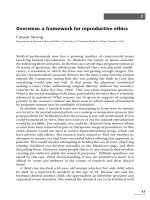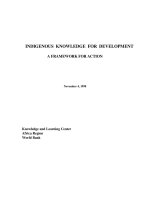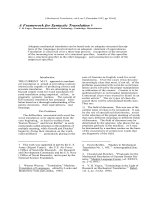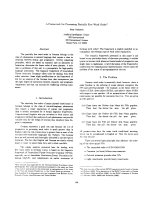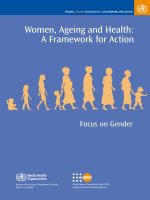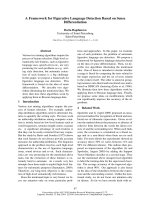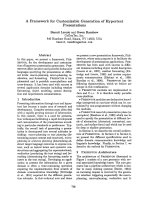Overview - a framework for reproductive ethics
Bạn đang xem bản rút gọn của tài liệu. Xem và tải ngay bản đầy đủ của tài liệu tại đây (219.77 KB, 22 trang )
2
Overview: a framework for reproductive ethics
Carson Strong
Department of Human Values and Ethics, University of Tennessee Medical College, Memphis, USA
Medical professionals now face a growing number of controversial issues
involving human reproduction. To illustrate the variety of issues, consider
the following three scenarios. In the Wrst case, involving a pregnant woman at
36 weeks of gestation, the obstetrician believed there was placental insuY-
ciency, a condition in which the fetus was not getting enough oxygen. The
doctor recommended Caesarean delivery for the fetus’s sake, but the woman
refused the Caesarean, stating that she was putting her faith in God that
everything would turn out well. At that point, the physician considered
seeking a court order authorizing surgical delivery without the woman’s
consent (In Re Baby Boy Doe, 1994). This case raises important questions.
What is the moral standing of the fetus, particularly the fetus that is relatively
advanced in gestation? What reasons can be given in support of assigning
priority to the woman’s wishes? Are there cases in which refusal of treatment
by pregnant women may be justiWably overridden?
In another case, a research team was attempting to learn how to mature
ova in vitro. In normal reproduction, ova undergo a maturation process that
prepares them for fertilization, but the process is not well understood. If ova
could be matured in vitro, then new sources of ova for assisted reproduction
would be available. For example, ova could be obtained from donors whose
ovaries have been removed as part of therapeutic surgical procedures. In that
event, donors would not have to receive hyperstimulation drugs, which can
have adverse side eVects. The research team wanted to Wnd out whether its
attempts to mature ova had been successful before oVering this approach to
patients. This would involve attempting to fertilize the ova in vitro, observing
whether fertilized ova develop normally to the blastocyst stage, and then
discarding them. However, some people object to any research that involves
creating pre-embryos solely for research purposes.
1
DiYcult questions are
raised by this case. What moral standing, if any, do preembryos have? Is it
ethical to create pre-embryos in the course of research and then discard
them?
A third case involved a 63-year-old woman who lost her only child when
he died in a motorcycle accident at the age of 18. Because she and her
husband desired another child, she approached an infertility specialist and
requested ovum donation. She wanted the donated ova to be fertilized with
17
her husband’s sperm and then transferred to her uterus, and her 65-year-old
husband agreed with this plan (Carlson, 1994). This case also raises contro-
versial issues. Is freedom to procreate important enough that we should
permit postmenopausal women to become pregnant, if that is what they
want?
One could give many more examples of new situations created by advances
in reproductive and perinatal medicine. When we attempt to grapple with
these many issues, we repeatedly come back to several central ethical ques-
tions. What is the moral standing of pre-embryos, embryos and fetuses? How
much importance should be given to procreative freedom? Is procreative
freedom valuable simply because freedom in general is valuable, or is there
special signiWcance to the fact that the freedom in question is procreative?
Need for an ethical framework
To resolve ethical issues in reproductive medicine, we need answers to these
central questions. Although there is no way to prove what the correct answers
are to these main questions, we can give arguments for and against diVerent
answers, and we can try to decide what answers are best supported by
arguments. That is what ethics is all about – it involves looking at all sides of
issues and trying to assess the relative merits of diVering views. If we had
reasonable answers to these central questions, then we would have what I am
calling a framework for dealing with these issues. A framework is just a
starting place. For any particular case or issue, it usually will be necessary to
bring in additional considerations, facts and arguments in order to arrive at a
conclusion. The framework is a way of articulating some of the basic prin-
ciples from which one argues.
A framework can be based on religious beliefs, or it can be secular. This
chapter focuses on a secular framework. Even though many of us have
religious beliefs that inXuence our thinking about ethics, we still need a
secular framework. This is because many of the cases in reproductive ethics
raise policy issues – questions concerning what we as a society should permit
or forbid. Should we allow ovum donation for ‘older’ women? Should we
forbid the creating of pre-embryos solely for research purposes? It is not
appropriate for the views of a particular religion to determine public policy,
especially if it is a minority viewpoint. For example, it would be wrong to
have a law stating that no one may use in vitro fertilization, simply because a
particular religion holds that it violates God’s commandments. By a ‘secular’
framework, I mean one whose defence does not depend on any particular
religious viewpoint. The fact is, little attention has been given to articulating a
secular ethical framework for reproductive and perinatal medicine. This is so,
despite the fact that there has been much debate over individual issues.
18 C. Strong
I would like to suggest that an adequate framework should contain at least
the following components. First, it should explore and assess the importance
of reproductive freedom. What meaning and signiWcance do we attach to
having children? Why should procreative freedom be considered valuable?
Secondly, a framework should put forward and defend a view concerning the
moral status of oVspring during the pre-embryonic, embryonic, fetal and
postnatal stages of development. Thirdly, it should put forward an approach
to the problem of assigning priorities when diVerent ethical values or inter-
ests are in conXict. Its approach to prioritizing should be capable of taking
into account all relevant ethical considerations, and it should provide practi-
cal guidance in resolving policy questions and individual cases. This chapter
will put forward and attempt to defend such a framework.
Significance of freedom to procreate
Let us begin with reproductive freedom, which includes freedom to procreate
and freedom not to procreate. It turns out that these two components of
reproductive freedom are important for diVerent reasons, so we shall con-
sider them separately. To explore the signiWcance of freedom to procreate, we
need to ask why having genetic oVspring is important to individuals. What
reasons can be given for valuing the having of genetically related children?
Are there good reasons to protect freedom to have genetic oVspring?
To answer this question, I suggest that some insight can be gained by
starting with what might be called ‘ordinary procreation’ – not involving in
vitro fertilization, ovum donation or any type of assisted reproduction. I refer
to the type of procreation in which a couple begets, by sexual intercourse, a
child whom they rear. This is the more common type of procreation, in
which parents raise children genetically their own. My strategy is to try to
understand why having genetic oVspring might be meaningful to people in
this ordinary scenario, and then use this understanding to address the newer,
more controversial situations.
Studies have identiWed a number of reasons people actually give for having
genetic children, some of which seem selWsh or confused (Pohlman, 1974;
Arnold, 1975; Laucks, 1981). For example, some people desire genetic oV-
spring as a way to demonstrate their virility or femininity. The views on
which these reasons seem to be based – that virility is central to the worth of a
man, and that women must have babies to prove their femininity – are
unwarranted. They stereotype sex-roles and overlook ways self-esteem can be
enhanced other than by having genetic oVspring. By contrast, we want to
consider whether reasons can be given that are capable of being defended. To
be clear, what we are about to explore is not the descriptive question of what
reasons people actually give, but the normative question of whether there are
19Overview
reasons that could be given to help justify the desire to have genetic children.
There are several reasons that can be given, but for brevity only four will be
mentioned here.
2
First, having a genetic child might be valued because it involves participa-
tion in the creation of a person. When one has a child in ordinary procreation,
a normal outcome is the creation of an individual with self-consciousness.
The term ‘self-conscious’ implies not only being conscious, but also being
able to reXect on the fact that one is conscious. Philosophers have regarded
the phenomenon of self-consciousness with wonder, noting that it raises
perplexing questions. What is the relationship between body and mind? How
can the physical matter of the brain give rise to consciousness and self-
consciousness? It is ironic that although we have diYculty giving satisfactory
answers to these questions, we can create self-consciousness with relative
ease. Each of us who begets or gestates a child who becomes self-conscious
participates in the creation of a person. One might say that in having children
we participate in the mystery of the creation of self-consciousness. For this
reason, some might regard creating a person as an important event, perhaps
one with spiritual overtones. Some might think of it as acting as an instru-
ment of God’s will. Others might consider it to be the fulWllment of religious
duty. Thus, the idea of creating a person can have diVerent types of special
meaning. Perhaps not all who have children think about it in terms of
creating a person, but this is a reason that can be given to help justify the
desire for genetic oVspring.
Second, having genetic children might be valued as an aYrmation of a
couple’s love and acceptance of each other. It can be a deep expression of
acceptance to say to another, in eVect, ‘I want your genes to contribute to the
genetic makeup of my children.’ Moreover, in such a context there might be
an anticipation that the bond between the couple will grow stronger because
of common children to whom each has a biological relationship. To seek
intentionally the strengthening of their personal bond in this manner can be a
further aYrmation of mutual love and acceptance.
Third, procreation can provide a link to future persons. Some might value
having such a genetic link, for various reasons. Some might think of it as a
personal contribution to the future of the human community and its sur-
vival. For others, it might enter into a judgement about how one’s life counts
and how far its inXuence extends (Dyck, 1973).
A fourth reason is that having children can be meaningful in part because it
involves experiences of pregnancy and childbirth. It should be acknowledged,
of course, that some women do not Wnd such experiences to be desirable.
Discomforts can be signiWcant, such as back pain, nausea and feeling tired.
There can be other negative experiences, such as anxiety over the baby’s
health, fear of dying, insomnia, irritability and mood swings. And of course
there is the pain of labour, or if Caesarean section is performed, the pain
20 C. Strong
associated with abdominal surgery. Despite these negatives, some women
Wnd the experience on balance to be valuable. One of the satisfactions
sometimes experienced by pregnant women is increased esteem or attention
from others. Another is a feeling of joy sometimes experienced immediately
after the birth of the child. Pregnancy is viewed by some as a learning
experience that contributes to personal development and enrichment. Also,
the satisfaction that derives from altruistic behaviour should not be over-
looked, given that pregnancy can involve signiWcant sacriWces for the sake of
the fetus. These are some of the reasons a woman might give to explain why
the experiences of pregnancy and childbirth are personally meaningful.
In stating these four reasons, I do not mean to imply that one ought to
desire genetic oVspring, but only that the desire can be defended. These are
examples of reasons that are not silly or confused. Rather, they are reasons
that deserve consideration. These reasons suggest that procreation can be
valuable to an individual in part because it can contribute to self-identity,
one’s sense of who one is. For example, having participated in the creation of
a person can be part of one’s self-identity. Similarly, whether one has given
birth or has obtained a certain kind of link to the future can be part of one’s
sense of who one is. These reasons also suggest that procreation can contrib-
ute to self-fulWllment, for it can result in marital love being enriched.
These reasons also help explain why freedom to procreate should be valued;
namely, because procreation can be important to persons in the ways just
discussed, including contributing to self-identity and self-fulWllment. Be-
cause of these considerations, interference with freedom to procreate can
constitute a failure to give individuals the full respect they deserve as persons.
This does not mean that freedom to procreate is never outweighed by other
ethical concerns. Rather, it means that there are valid reasons to respect
freedom to procreate, which implies that interferences with such freedom
must be justiWed by appeal to overriding ethical considerations.
Importance of freedom not to procreate
Now let us consider why freedom not to procreate can be valuable. First, this
freedom can be important for directing the course of one’s life. Having
children is a large undertaking that competes with other important goals and
projects in one’s life by placing demands on time, energy and resources. Thus,
self-determination in making major life choices is promoted by freedom to
decide whether to have children (or, for those who already have children,
whether to have additional children).
Second, freedom not to procreate is important because it has a bearing on
the freedom to make decisions concerning what happens to one’s body.
Bodily self-determination is relevant to decisions concerning sterilization,
21Overview
use of birth control pills and abortion, among other examples. Although
bodily self-determination applies both to men and women, it has special
signiWcance for women because they bear the burdens of gestation.
The third reason focuses speciWcally on the interests of women. For women
to gain political, social and economic equality, it is essential that they have
freedom to control their reproductive lives. Equality for women requires,
among other things, greater integration of women into positions of authority
and inXuence in all Welds of endeavour. Because childbirth and childrearing
require much time and energy, the more heavily one’s life is devoted to these
activities, the more diYcult it is to pursue education and careers leading
to positions of authority. Society generally has put little pressure on men
to participate in child-rearing, and women have shouldered most of the
responsibilities in this area. For women as a group to be no longer held back,
they must be free to make decisions about when and whether to try to have
children.
This third reason has been articulated primarily by feminist writers, and it
has received relatively little attention in mainstream medical ethics. Although
there is considerable diversity of views among feminist writers, it is important
to take note of common themes that run through the feminist literature on
reproductive issues. Several authors have attempted to identify these main
ideas (Overall, 1987: pp. 1–16; Andrews, 1989; Sherwin, 1989), and they
include the following. First, a feminist perspective is founded upon an
awareness that women have been and are the victims of unjustiWed limita-
tions and barriers under a system of male dominance. Second, a feminist
perspective seeks removal of this oppression of women and the bringing
about of sexual equality. Third, with regard to reproduction, women should
not be exploited. They should have control over their bodies, gametes and
conceptuses. The medicalization of pregnancy and childbirth has resulted in
a loss of control that should be reversed. Fourth, in formulating policies
concerning reproductive issues, greater attention must be given to the input
of women concerning their interests, needs and perspectives. It is important
for mainstream medical ethics to give more attention to these concerns.
Moral standing of the fetus and embryo
Let us turn to the moral status of pre-embryos, embryos, fetuses and infants.
It will be helpful to begin by discussing a number of secular views that have
been put forward concerning when personhood begins. In this context,
‘personhood’ refers to a moral status that we might call ‘full moral standing’.
It involves having a substantial set of rights, including a strong right to life.
All of the views that will be discussed have a feature in common; they all claim
that personhood begins when some special characteristic is acquired. Each
22 C. Strong
view, however, puts forward a diVerent characteristic. We shall consider these
views not only to identify their shortcomings, but also to point out the
helpful insights they provide.
One view is that individuals become persons and acquire a right to life
when they become self-conscious (Tooley, 1972). Because self-consciousness
involves being able to reXect on the fact that one is conscious, it requires
concepts and language – concepts such as consciousness and self. A paradigm
example of a self-conscious individual would be a normal adult human being.
By contrast, lower animals that lack concepts and language can be conscious
but are not self-conscious.
However, there is a serious diYculty with the view that one must be
self-conscious in order to be a person. The problem lies in its implications for
infants. Infants are not self-conscious, given that they lack language and the
concepts one must have in order to be self-conscious. Thus, according to the
view in question, infants lack a right to life. However, this is at odds with our
moral intuitions, according to which infants have moral interests that deserve
protection, including a right to life. Therefore, the view in question should be
rejected. Nevertheless, there is an important point to be gleaned from this
view, namely, that everyone who is self-conscious has full moral standing
precisely because they are self-conscious, even though one doesn’t have to be
self-conscious to have moral standing, as exempliWed by infants.
AdiVerent view is that the potential to become self-conscious gives one
personhood status (Devine, 1978). On this view, the embryo is a person
because it has that potential. However, there is a problem with this view,
which can be illustrated by the following scenario. Let us assume that it is
possible to keep embryos alive in the laboratory, at least for a short period of
time. Let us also assume that it is possible to transfer one of these laboratory
embryos to a woman’s uterus, which means that even when it is in the
laboratory the embryo has the potential to develop into a self-conscious
individual. Now, suppose that you walk into a laboratory and see that a Wre
has broken out. You see a child, approximately 10 years old, lying on the
Xoor, suVering from heat and smoke. You also know that in this laboratory
there is an embryo being kept alive by some equipment that is regulating its
environment. You face a choice: either to carry out the child or to carry out
the embryo with the life-support equipment to which it is attached. Assume
that you are unable to carry out both of them. Which one should you
rescue?
3
Clearly, the morally correct choice is to rescue the 10-year-old child. This
example shows that the embryo’s potential to become self-conscious does not
give it full moral standing. If it had full moral standing, then the decision
concerning whom to rescue would be much more diYcult. Nevertheless,
this view suggests an important insight, namely, that the potential to be-
come self-conscious has some moral signiWcance. If an embryo’s potential is
23Overview
actualized, then a person will come into existence, and that would be an event
having moral import.
Some believe that the fetus becomes a person when it acquires sentience –
that is, the capacity for feeling or perceiving (Sumner, 1981). However, the
view that sentience by itself gives rise to personhood has broad implications
that seem incorrect. Lower animals also are sentient. So, this view implies that
animals have a right to life that is equal in strength to that of humans. This is a
conclusion that will strike many of us as implausible. So, this view also should
be rejected. But even so, sentience is a morally relevant characteristic. The
reason is that one must be sentient in order to have moral interests. Plants,
for example, are not sentient and therefore lack moral interests. Of course,
you can nurture a plant and cause it to Xourish, but the plant itself lacks any
interest in whether you do this. By contrast, lower animals that are sentient
have interests. For example they have an interest in avoiding pain and other
unpleasant experiences. So, sentience is relevant to moral standing.
Another view is that the fetus becomes a person when it becomes viable.
Those who hold this view often fail to realize that whether or not a given fetus
is viable is relative to the state of our technology. The problem with the
viability criterion can be seen by considering another version of the Wre-in-
the-lab example. This time, imagine that our technology has advanced to the
point at which the embryo could be kept alive and developed in the labora-
tory until it grows into an infant. In other words, the embryo is viable in this
scenario because so-called extra-corporeal gestation is possible. Again, you
enter the lab, discover a Wre, and have to choose between carrying out the
10-year-old child and carrying out the embryo and the equipment to which it
is attached. The ethically preferable decision is still to rescue the 10-year-old,
and this helps us to see that viability by itself does not give rise to personhood.
Others have argued that personhood begins with birth (Warren, 1989).
The reason, they claim, is that when the infant is born it enters into a network
of social relationships with other members of the human community. They
claim that having this social role is what provides the basis for moral
standing. The diYculty with this view is that the fetus can occupy a social role
even before birth, involving relationships with various individuals. The
pregnant woman, for example, can act in ways that promote or detract from
the fetus’s health. She can attend to the needs of her fetus by avoiding
smoking and excessive alcohol use, eating nutritious meals and seeking
treatment for medical problems of her own that can adversely aVect the fetus,
such as hypertension and diabetes. In addition, obstetricians can monitor the
health status of the fetus and provide treatment or early delivery when
necessary. For these reasons, a matrix of social relations between fetus and
others is often present well before birth. Thus, it is diYcult to argue that birth
constitutes a sharp dividing line between those who are part of a network of
social relationships and those who are not.
24 C. Strong
